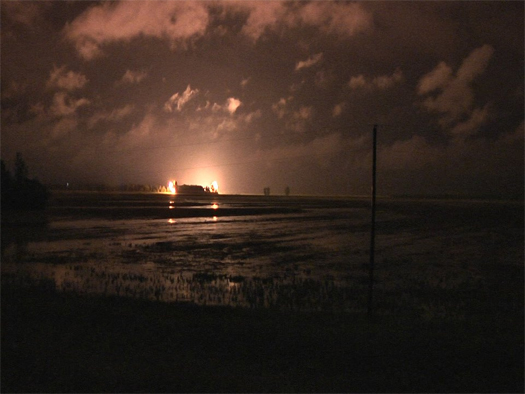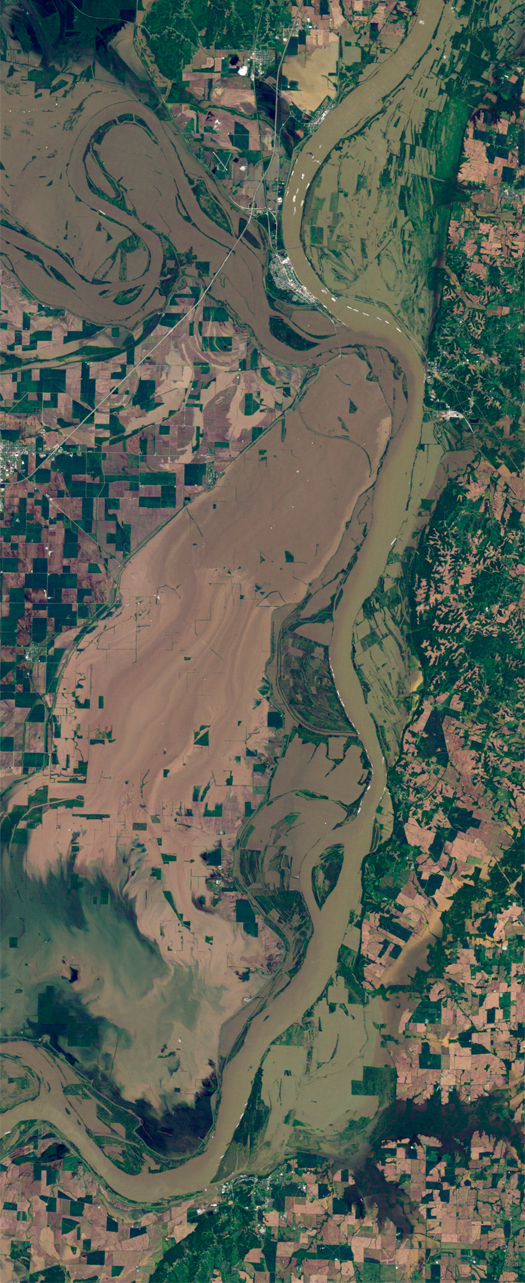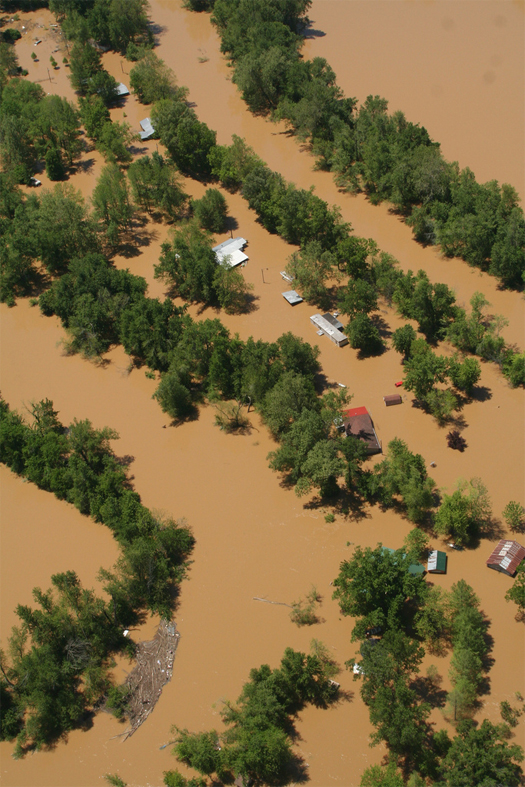
[Detonation at the Birds Point inflow crevasse, during the night of 2 May 2011.]
As sand boils appeared in Cairo, the swollen rivers continued to rise. The city was under mandatory evacuation orders, and the flood gauge was expected to reach 63 feet — not high enough to over-top the city’s levees, but high enough to make failure quite likely. Across the Mississippi, though, there was a release valve: the Birds Point-New Madrid floodway, an eighty-year old emergency fuse constructed, like much of the Mississippi River’s flood control infrastructures, in the wake of the 1927 floods and the hard lessons that flood taught about the futility of relying on levees alone.
Though much of the media coverage of the decision to pump blasting agents into the “horizontal polyethylene pipes” that sat within the “inflow crevasse” at Birds Point — and ignite them — focused on the attempts by the state of Missouri to halt the opening of the floodway, the lighting of this fuse is essentially automatic, triggered by long-settled legal provisions governing the Army Corps operations. When the Cairo gauge reads 59, preparation for demolition of the levee at the inflow crevasse begins. When it reads 60, preparations are to be completed. When it reads 61, the Army Corps is to detonate the levee and open the floodway. In May, despite the state of Missouri’s injunction, the levee was opened at 61.5, and the Birds Point-New Madrid floodway filled with muddy water.


[Top, the floodway in operation, 3 May 2011, via NASA Earth Observatory; above, inundation in the floodway, via MoGov.]
The floodway operated as designed, and the levees never failed in Cairo. (Once the floodway was opened, “water levels in the Mississippi at Cairo dropped more than 30 cm within hours.”) This is little consolation (not none, but little), of course, to the farmers who lost fields and equipment and houses in the floodway; but the unfortunate tendency of media reporting on flooding, as Steve Gough points out, is to emphasize the narrative of disaster — the Corps blew up a levee, and farmers lost their property — at the expense of describing the structural framework (the infra-natural confluence of systems) which that narrative is embedded in. (In this case, that framework is cobbled together from both physical and legal infrastructures — levees, blasting pipes, fuse plugs, and artificial crevasses mingling with flowage easements, the Army Corps’ binding legal framework, and an eighty-year-old emergency plan that has only been put into action twice.) But so long as we continue to talk primarily about those micro-narratives, rather than the larger framework, we will be unable to evaluate whether the framework is actually working, and whether there are better infrastructural systems (and systems of urbanization) that could be developed.
[It’s also worth noting that this is a perfect example of why I’ve described the Mississippi River floods as infra-natural disaster, rather than merely natural disaster; nature may have provided the floodwaters, but the specific velocity and volume of floodwater was produced by the configuration of infrastructural systems, and the confluence of physical and legal infrastructures controlled where disaster appeared.]


that is a great point about the media. Critical, in fact.
your argument for understanding them as infra-natural disasters is winning me over, despite the clunky term itself :)
In your mind, does making this argument open up some avenue or even imperative for designers and engineers to find ways of contributing to the larger discourse? It’s something Downing and Olmsted used to do a lot of, writing for the NY Times to influence public opinion… Not sure how we could pull that off today. And maybe that’s not even the point you’re making here, but it strikes me.
What’s clunky is the emoticon that my blog has made out of your typing.
But, yes, I do think there’s something critical about the media, or, at least, “media” (without the “the”). I’m not sure that writing for the New York Times is necessarily going to have the same kind of effect that it did when Olmsted was doing it, as media culture is so fragmented. (This is not, by the way, an argument against writing for the Times; just an argument that it can’t be expected to have the same kind of reach and efficacy that it might once have had. Multiple prongs are now required.)
Quibbles about the media vs. media aside, I wouldn’t have any problem with asserting that there is an imperative for designers (and engineers, though I’m not one so I tend to back off telling them what to do in the way that I’m comfortable doing so with designers) to engage a larger discourse, specifically in the case of flood-control infrastructures, as well as more broadly on infrastructure and urbanization generally.
yes, seeing that emoticon pop up was embarrassing; it was like when you hit “lock” and push the car door closed, only as it’s closing you see your keys still in the ignition and you awkwardly try to stop the door from shutting, but it’s too late and you just look dumb and your keys are locked in. that’s how it felt.
As much as I enjoy your embarrassment, I can’t handle seeing that icon. Found the setting to turn emoticons off. Much better now…